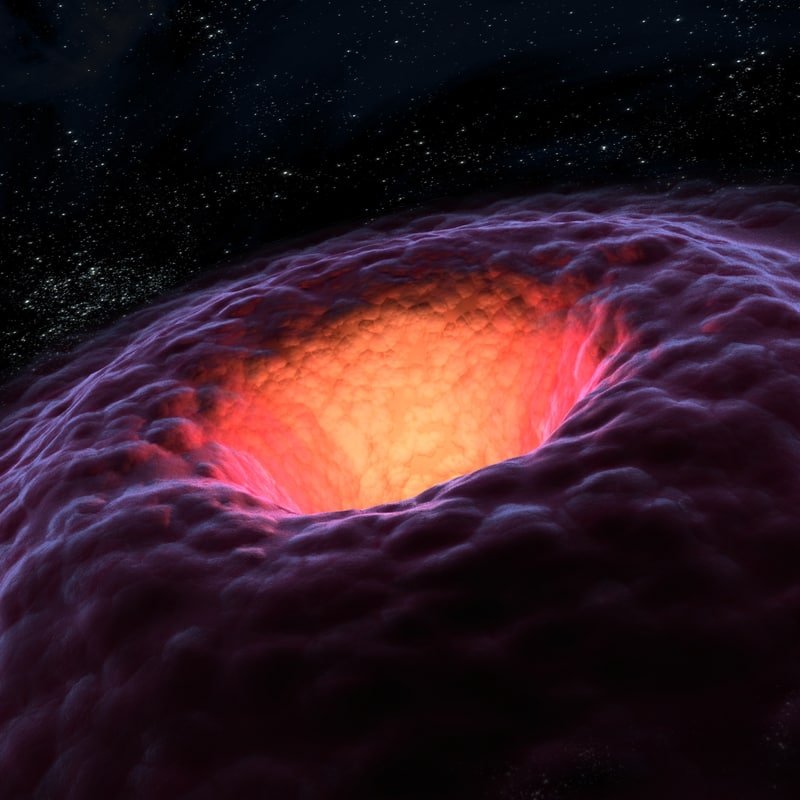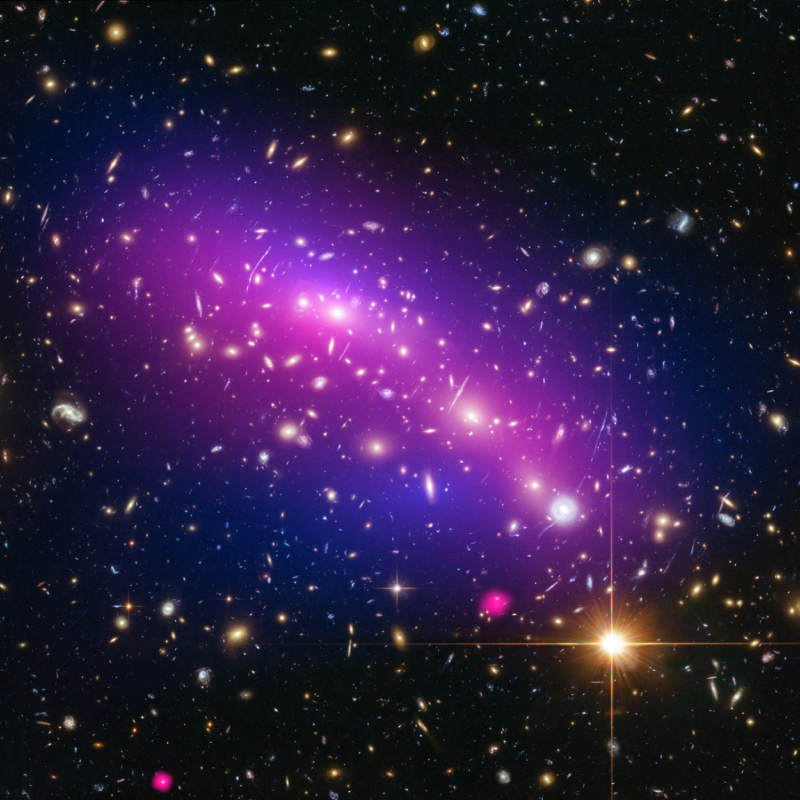Black holes have been a mystery for the scientists for a long time. There are many theories about black holes as well as white holes. Before going into detail let’s first define what the black holes really are. A black hole is a region of a spacetime exhibiting such strong gravitational effects that nothing—not even particles and electromagnetic radiation such as light—can escape from inside it. The theory of general relativity predicts that a sufficiently compact mass can deform spacetime to form a black hole, so the black hole is a region of space-time where extremely strong gravity prevents anything, including light escaping from. We know that matterfalling into black holes is no different from the matter which can be found lurking around the rest of the Universe. Black holes have a finite lifetime due to the emission of Hawking radiation. However, for most known astrophysical black holes, the time it would take to completely evaporate and disappear is far longer than the current age of the universe.
What are wormholes?
According to the special theory of relativity, the laws of physics are the same for all non-accelerating observers and the speed of light within a vacuum is the same, no matter the speed at which an observer travels, so it means that a white hole is a hypothetical region of spacetime which cannot be entered from the outside, although matter and light can escape from it. In this sense, it is the reverse of a black hole, which can only be entered from the outside and from which matter and light cannot escape. The theory of general relativity predicts that a sufficiently compact mass can deform space-time to form a black hole.
“White holes, which are theoretically the exact opposites
Of black holes could constitute a major portion of the
Mysterious dark matter that’s thought to make up most
Of the matter in the universe.”
What are wormholes?
A wormhole is consistent with the general theory of relativity, but whether wormhole actually exists remains to be seen. A wormhole could connect extremely long distances such as a billion light-years or more, short distances such as a few meters, different universes, or different points in time.
Now we know the actual difference between black and white holes is that light cannot escape from a black hole and contrary cannot enter into a white hole. Another difference one might hope to exploit is that unlike black holes, wormholeshave no event horizon. This means that things could go in a wormhole and come back out again. In fact, theorists say one variety of wormhole wraps back onto itself, so that it leads not to another universe, but back to its own entrance. There are a couple of theories, let’s discuss them in detail.
Theory1:
White holes, which are theoretically the exact opposites of black holes, could constitute a major portion of the mysterious dark matter that’s thought to make up most of the matter in the universe, a new study finds. And some of these bizarre white holes may even predate the Big Bang, the researchers said.
Furthermore, Black holes possess gravitational pulls so powerful that even the light which is the fastest thing in the universe, cannot escape them. The invisible spherical boundary surrounding the core of a black hole that marks its point of no return is known as its event horizon.
A black hole is one prediction of Einstein’s theory of general relativity. Another is known as a white hole, which is like a black hole in reverse: Whereas nothing can escape from a black hole’s event horizon, nothing can enter a white hole’s event horizon.
Previously, researchers have suggested that black holes and white holes are connected, with matter and energy falling into a black hole potentially emerging from a white hole either somewhere else in the cosmos or in another universe entirely. In 2014, Carlo Rovelli, a theoretical physicist at Aix-Marseille University in France, and his colleagues suggested that black holes and white holes might be connected in another way: When black holes die, they could become white holes.
“The dark matter is invisible; it does not emit,
Reflect or even block light. As a result, dark
Matter can currently be tracked only through
Its gravitational effects on normal matter, such
As that making up stars and galaxies.”
Theory2:
Black holes nowadays are thought to form when massive stars die in giant explosions known as supernovas, which compress their corpses into the infinitely dense points known as singularities at the hearts of black holes. Rovelli and his colleagues previously estimated that it would take a black hole with a mass equal to that of the sun about a quadrillion times the current age of the universe to convert into a white hole.
However, prior work in the 1960s and 1970s suggested that black holes also could have originated within a second after the Big Bang, due to random fluctuations of density in the hot, rapidly expanding newborn universe. Areas, where these fluctuations concentrated matter together, could have collapsed to form black holes. These so-called primordial black holes would be much smaller than stellar-mass black holes, and could have died to form white holes within the lifetime of the universe, Rovelli and his colleagues noted.
However, even white holes with microscopic diameters could still be quite massive, just as black holes smaller than a sand grain can weigh more than the moon. Now, Rovelli and the co-author of research Francesca Vidotto, of the University of the Basque Country in Spain, suggest that these microscopic white holes could make up dark matter.
What is Dark matter?
Although dark matter is thought to make up five-sixths of all matter in the universe, scientists do not know what it’s made of. As its name suggests, dark matter is invisible; it does not emit, reflect or even block light. As a result, dark matter can currently be tracked only through its gravitational effects on normal matter, such as that making up stars and galaxies. The nature of dark matter is currently one of the greatest mysteries in astrophysics. The local density of dark matter, as suggested by the motion of stars near the sun, is about 1 percent the mass of the sun per cubic parsec, which is about 34.7 cubic light-years. To account for this density with white holes, the scientists calculated that one tiny white hole — much smaller than a proton and about a millionth of a gram, which is equal to about the mass of “half an inch of a human hair,” Rovelli said — is needed per 2,400 cubic miles (10,000 cubic kilometers). These white holes would not emit any radiation, and because they are far smaller than a wavelength of light, they would be invisible. If a proton did happen to impact one of these white holes, the white hole “would simply bounce away,” Rovelli said. “They cannot swallow anything.” If a black hole were to encounter one of these white holes, the result would be a single larger black hole, he added.
Theory3:
The Black holes are common in the cosmos—nearly every large galaxy harbors a supermassive one in its nucleus, not to mention smaller specimens. However, astronomers have yet to identify a single white hole. That doesn’t rule out their existence entirely since it might be hard to see one: If they effectively repel particles, there’s a small possibility they could be lurking out there somewhere, invisible. Nevertheless, none of all the diverse objects astronomers have observed seem to resemble what we’d expect from white holes.
An even larger problem arises when we consider how white holes could form. Black holes are the end result of gravitational collapse. When a star at least 20 times the mass of the Sun exhausts its usable nuclear fuel, it can no longer produce enough energy to balance the inward force of gravity. At that point, the core collapses on itself, reaching ever higher densities until its gravity is so intense that not even light can escape. That results in a black hole with a mass comparable to a large star. Supermassive black holes, which are millions or billions of times heavier than that, form by some currently unknown mechanism.
In any case, they still are the result of the gravitational collapse, whether from a huge super-star born in the early days of the Universe, a huge cloud of gas at the heart of a primeval galaxy, or some other phenomenon. Forming a white hole, however, would require something akin to a gravitational sewer explosion, and it’s not clear how that sort of event could ever occur. One possibility is that white holes might be “glued” to black holes. In this view, a black hole and white hole are two sides of the same thing, connected via a wormhole, a concept familiar from many science-fiction stories, a similar principle proposed for a “warp drive”—but no evidence for such material exists.
Conclusion:
A probable conclusion of the above discussion is that our Universe contains a multitude of black holes but no white holes. That’s not because of a fundamental asymmetry in time—general relativity still works just as well either way time flows—but due to the nature of gravitational collapse: It only works one way. This parallels the situation with the entire cosmos: There was a Big Bang, an initial expansion of all we observe, apparently from a single point. But the evidence points pretty strongly against the possibility of a Big Crunch, a re-collapse of all we observe into a single point sometime in the distant future. If current trends continue (specifically if dark energy doesn’t drastically change its character), the Universe will continue to expand forever at an ever-faster rate.
Just because the equations of general relativity allow white holes and big crunches, warp drives and wormholes doesn’t mean these things actually exist in nature. The asymmetry of time in gravity isn’t inherent but seems to arise from the behavior of matter and energy: gravitational collapse at the end of time, initial expansion at time’s beginning. The deep meaning of that is something physicists are still trying to comprehend.
Mahnoor Tabassam is a student at LACAS. She’s very passionate for astronomy.




